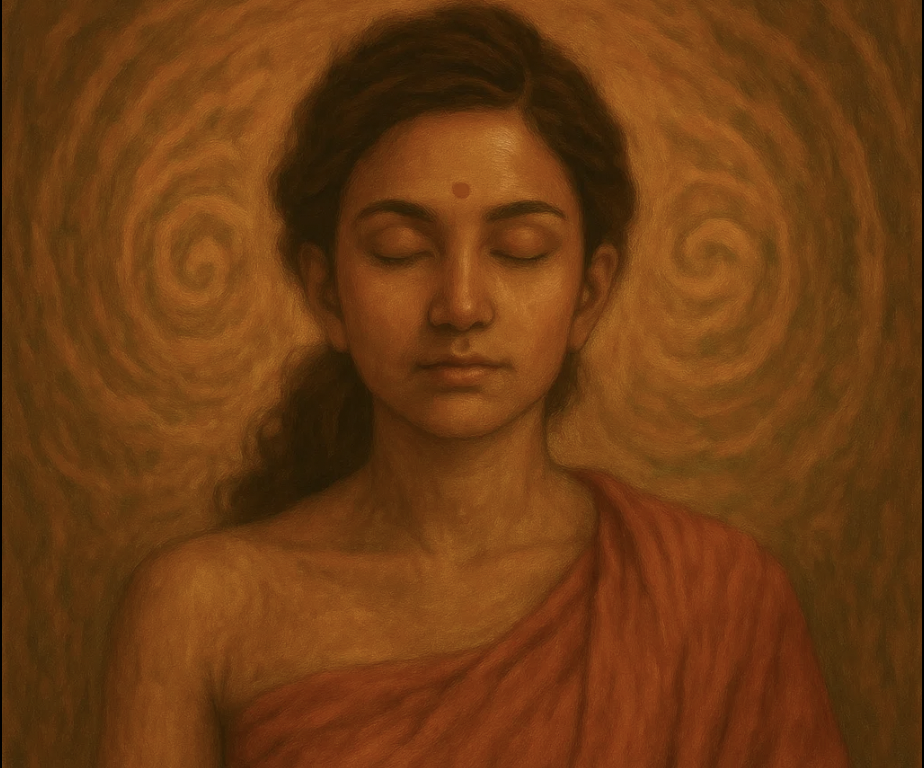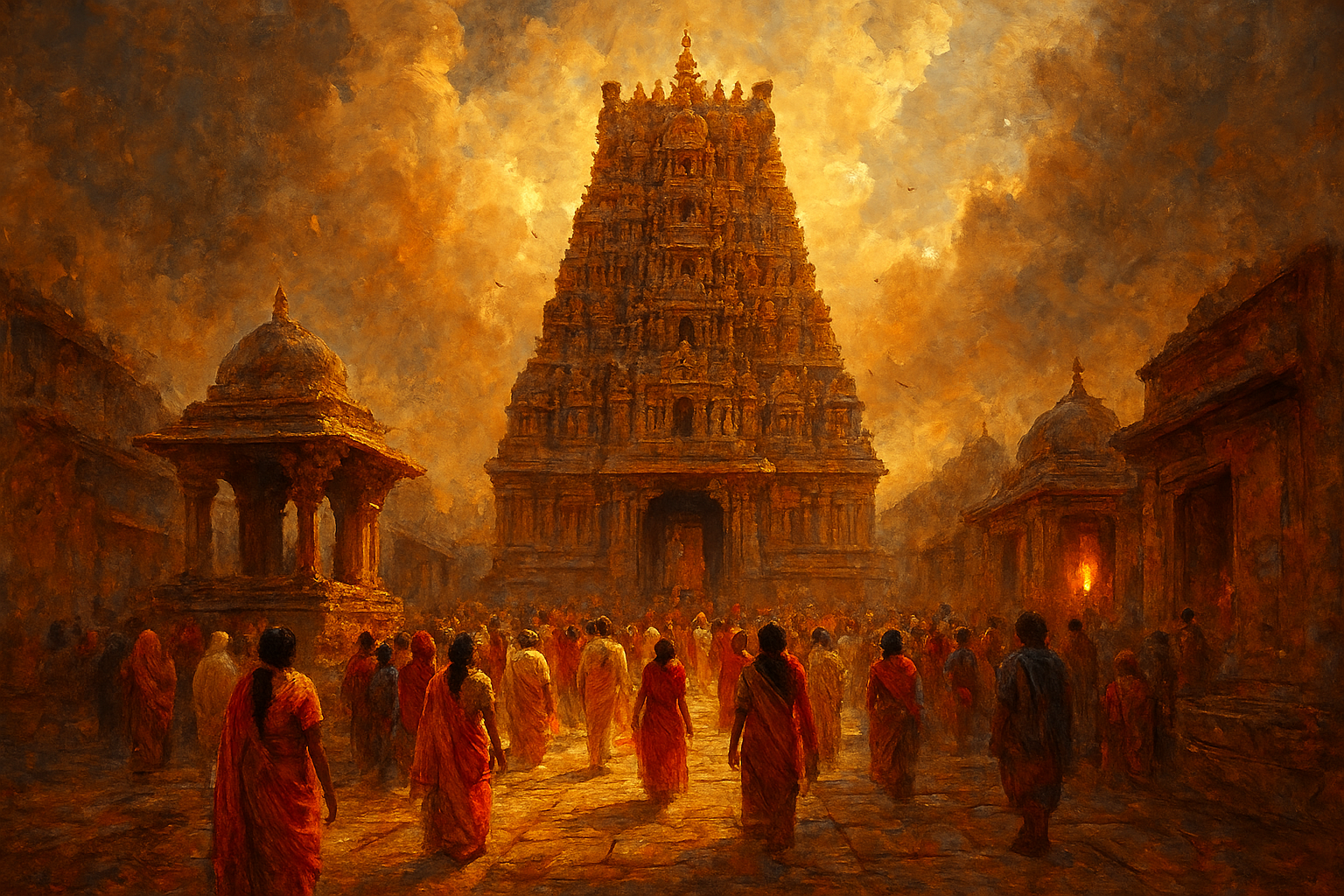Sanatan Dharma is one gorgeous web of many colorful beliefs.
It’s probably the most inticrate, well-preserved, timeless way of life that we Gen-Zs have access to today. Studying it seriously can offer many answers to the questions that keep us anxiously awake at night.
There are so many schools of thought, rituals, traditions, deities, customs and pathways to explore.
As invaders from up top arrived in India, crossing the Sindhu nadi (the local name for the Indus river), they grouped these various sects of people practicing Sanatan Dharma, into one large cluster called “Hinduism”, labelling us Sanatanis as Hindus.
Now whether you call it Sanatan or Hinduism, its diversity can quickly sour into complexity, becoming problematic for curious newcomers, who have no clue about where to begin and how to continue without feeling completely overwhelmed.
This guide aims to make that entry simple so that you can embark on the spiritual journey that will challenge and change the way you think about this universe, your place in it, and your purpose for being alive.
Here’s a step-by-step guide to becoming a Hindu – understanding how to define it, converting into one, and living a Hindu life.

I. Defining a Hindu
Despite there being so many sampradayas (sects) in Hinduism, there is one universal definition available to us today.
Sanatan Dharma can be defined as the “way of life that focuses on realising your Oneness with the world by (a) striving to become your Highest Ideal Self (through restraint), (b) practicing righteousness in all walks of life (through morals), and (c) dedicating your lives to the service of this society (through service).”
Firstly, SD says that unless we ourselves are strong, we cannot lift others. This makes sense. But how do we become strong?In SD, physical, mental and emotional growth is possible primarily through restraint of or control over our senses, which are constantly distracted by material desires of food, sex, alcohol, drugs, uncleanliness and the likes.
Only with the senses in control, our energy can be directed to inner strengthening. We will learn more on how to do this in the chapter on Yoga.
Secondly, with our mind now strong, we follow strict ethics (niyams) when it comes to interacting with others – this includes ahimsa (do no harm or violence), asteya (do not steal), etc. When we start to consider the welfare of others, it prepares us to see from their perspective and empathise with them.Thirdly, with our focus on others, we end up dedicating our lives to making this society better and spreading the good vibes – by doing so, we achieve a continuous state of selflessness, which helps us kill the Ego, which gets us to moksha. That’s how the game is played.
Notice how nowhere in this definition you are obliged to believe in a God Almighty or even worship him every day – because yes, while Bhakti is a major key component of our lives, it is still a part of it, a pathway for the masses, but not a compulsory route.
Many people use Bhakti as a tool to start their journeys. Because seeing God in everyone, while the idea sounds cool, is not something everyone can easily grasp or continuously stick to. After all, an abstract Nirguna God is difficult to understand.
So we make up this separate entity called “God” (who is not us), consider him our Lord, give him a svarupa i.e. a form, and worship him – it’s just like hiring a personal trainer for your gym sessions – the idea of God will certainly help and guide you, but that’s just what it is – an idea, use it as you wish, it’s fine as long as you’re following the basics of being a Sanatani, which we’ll cover next!
Now let’s come to the definition of Hindus, people who practice Hinduism. The beauty is that this is an all-inclusive, all-encompassing definition, and hence applies to everyone regardless of which country you live in, which school you belong to, or which belief, rituals, practices and Gods/deities you follow.
A Hindu is someone who believes in our four core concepts called “DASY” – Dharma, Atman, Sampradaya & Yoga.
First, every Hindu is expected to fight for Dharma, which is social justice & reform for everyone, which means uplifting the society & helping others is our main ethical duty.
We are tolerant of all faiths, and inclusive of all people from different background, so we never try to or want to conquer, but the moment someone attacks or abuses our way of life, we not only have the right but our scriptures say it is our duty to defend, raise our voice & protect Dharma using any means necessary – Dharmo Rakshati Rakshitah – Dharma protects those who protect it.
Second, each Hindu believes in the concept of Atman, the eternal formless, quality-less soul within. In practice, this means treating everyone equally because we know deep inside, we’re all the same, and all the labels given to us, like our names, castes, class, sex, gender, sexual orientation, bodies, nationalities, religions, ethnicities, skin color, they are all false & temporary.
Third, a Hindu celebrates the power of diversity by accepting the roles of sampradayas within our ecosystem, and choosing to become part of one so that they can get the support of the community & find a guru within it to guide them on their journey. Shaivas, Naths, Vaishnavas, Pushtis, Jagannaths, Murrugan, Shaktas, Smartas, Ganpatyas, Advaitins, Dvaitins, ISKCONites, Aryas, Brahmos … these are all members of the same family.
Fourth, a Hindu believes that there are many paths to moksha or enlightenment, which is basically the highest point of self-awareness. The different paths, called “Yogas” are:
- Karma, the path of selfless action & hard work
- Bhakti, the path of loving devotion & complete surrender
- Dnyana, the path of knowledge & self-realization
- Raja, the royal path of deep meditation
And there are many others like Kriya, Ashtanga (Patanjali’s 8-fold path), etc.
All these yogas are complimentary to each other, lead to the same destination, and no one path is better than others. Hindus are free to choose their path as per their personality.
So how do you convert into a Hindu? There’s actually a process of that, too.
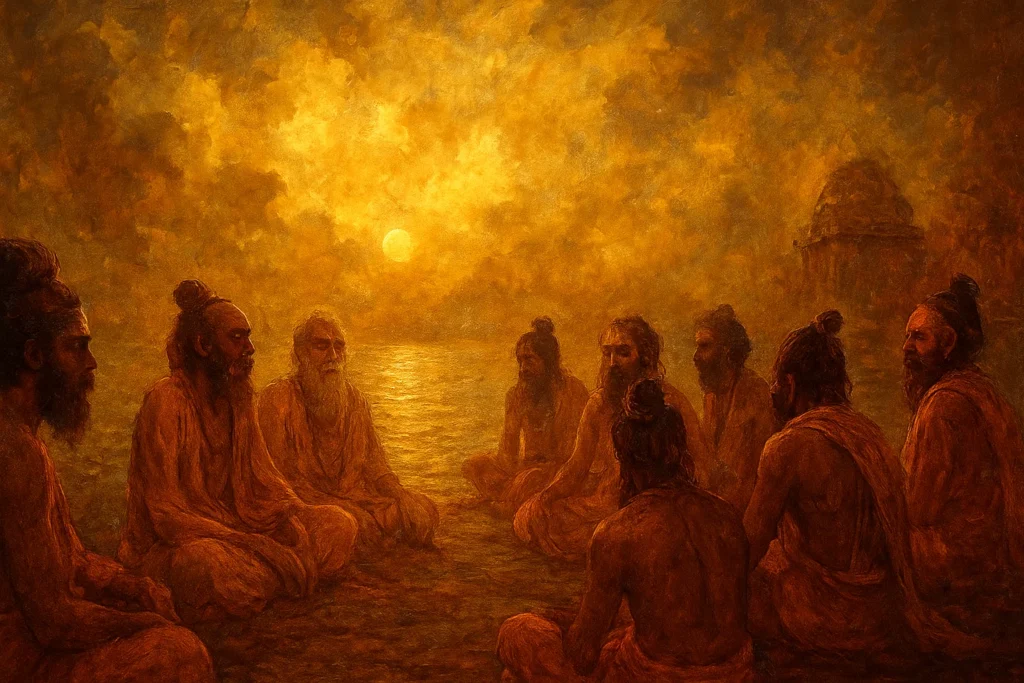
II. Basics of Hindu Conversion
You must’ve heard there’s no official conversion ceremony in Sanatan Dharma. But that’s not just false – it’s problematic. Because if someone wants to become a Hindu, they don’t know where or how to begin.
So let’s change that.
First off, the whole reason why there’s no official conversion, is because we believe that we are all born Sanātani. So you’re just returning to your roots, not joining a club. Second, Dharma’s main goal is to awaken people by helping them channelize their energy into social service & self-realisation. So it isn’t a missionary religion, and because we don’t want to conquer or pillage the world to establish our dominance, there was never an incentive to convert others, often done through force and deception by people of Abrahamic religions in the past.
But to give our Hindu way of life a bit more structure, we’ve developed systems like Ghar Wapsi and Shuddhikaran (purification) ceremonies. The former is more of a political grassroots social service conducted by nation-first groups like VHP (Vishwa Hindu Parishad) and RSS (Rashtriya Samaj Swayamsevak Sangh). And the latter is a service offered by Arya Samaj, a movement started by Swami Dayananda Saraswati.
You can look them up here and here.
These initiations usually include fire ceremonies (yagnas), homas (again, fire-based rituals), mantra-donation by the priest (in which you get your mantra i.e. spiritual code to recite everyday), and pledges to live a life rooted in ethics, compassion, and a strong sense of social duty.
A detailed conversion process is also prescribed in the book “How to Become a Hindu: A Guide for Seekers and Born Hindus” by Sivaya Subramuniyaswami, in which he also includes real anecdotes of people who found their path into this colorful community. You can buy your copy from Amazon here.
Regardless of who you seek guidance from, there are a few steps you can take to DIY (Do It Yourself) the whole Dharmic life.
III. Knowing our Sanskriti (Culture)
Hinduism is, above all, about self-realization. It has no other agenda, no greater purpose, than helping you, the jeeva (individual) realise its true nature as the Atman (soul), which has forgotten its reality as being the Brahman (the entire universe). That is why we say “Aham Brahmasmi” – I am the Universe.
Realization is not the same as saying it. Jnyana (knowledge) of the True Self is a long path of many tests, lots of doubt, and suffering, too. But it all begins with being curious about how everything works.
Most people have heard of the “Srimad Bhagavad Gita”, believed to be recited by one of the most popular Hindu deities, Sri Krishna, on the Kurukshetra battlefield in the epic of Mahabharata.
While that is a great starting point, it has many versions, some very exhaustive and therefore overwhelming for the beginner. Beyond it, people have no clue that there is an ocean of texts and resources to read.
You can now access not only the recommended concise (and detailed) versions of the Srimad Bhagavad Gita, but also dive into the top 50+ books and videos every Hindu should read & watch. Visit this open Notion Database. Most of the links lead to Internet Archive or other public platforms where the e-books are accessible for free (no copyright infringment intented, this is only for educaitonal purposes).
But if you’re a hardcore paperback reader, you can always use the same list to search them up on Amazon and grab your personal copies.
This database is neatly organized into three levels – Beginner, Intermediate and Advanced.
And its further arranged in the order of reading, so start from Book no. 1, which is my own “The Hindu’s Guide to the Brahmanda” (free for reading) and go in the recommended reading order, curated to suit even the most clueless beginners.
If reading is not really your cup of tea, you can just sit back and binge on the YouTube videos and Instagram Reels from these informative channels & pages, each of them covering their own niches or broad topic related to Indian/Bharatiya culture and Sanatan heritage.
If you have suggestions that would fit well in either of these lists, DM me @manikthinks on Instagram & I’ll promptly check them out!
IV. Showing up at Temples
Once you’ve started understanding our basics, its time to visit our temples – they are the soul of our communities, where we go to meet each other, conduct aartis & poojas (religious ceremonies) and find peace in chaos.
In temples, you will find the community, gurus, friends and answers you’re looking for – so do pay us a visit – we want to welcome you with open arms.
You do not have to be a practicing Hindu or have any sort of qualification and pre-requisite to enter 99% of the temples worldwide. Barring some exceptions which have some guidelines for logical reasons, virtually all Hindu temples are open for people of all backgrounds and orientations – rich or poor, Indian or non-Indian, male or female (with some exceptions), and children or the aged.
That said, to respect the sanctity of the place and not treat it like a tourist spot, please dress modestly in full clothes, covering your bottom half with jeans or full pants, and your upper half in either full or half sleeves (not gym t-shirts).
It is also advised not to eat meat/non-veg on the day you visit a temple as most Hindus (with some exceptions) believe in ethical, plant-based living (based on our principle of ahimsa) that excludes cruelty to animals by consuming their byproducts like meat, dairy, etc.
Beneath the intricate carvings and murtis (idols), through the peculiar gates, lies an intricate science and deep meaning that’s meant to connect the energy of the individual temple that is your body, with the larger grand design of the universe. You can read more about it here & here.
Just click this link or go to Google Maps and search “Hindu Temples near me.”
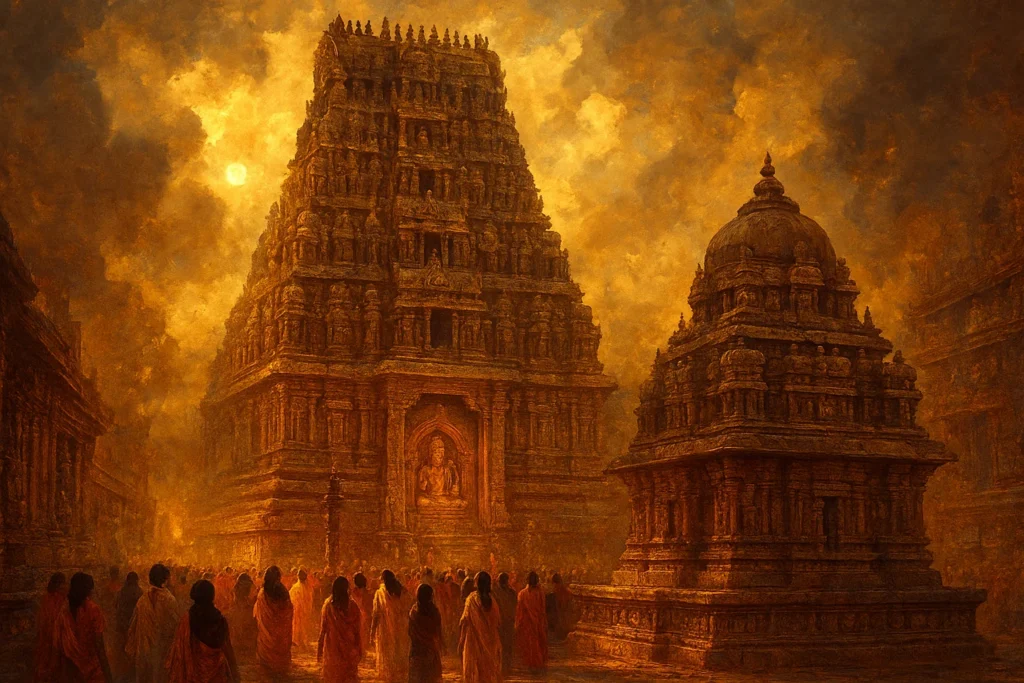
V. Severance & Hindu Naming
Once you visit a temple, you’ll likely be introduced to a sampradaya (sect), which will eventually become your new family.
But before you formally join that community, it is essential to bid farewell to your current/previous faith, so as to give yourself a clear closure before stepping back into your original identity as a Hindu.
You are technically not required to do this if you feel afraid for your safety, but most people would appreciate ending things so they can start afresh.
You may declare your exit from your religion or community publicly and write a letter like this one (free template) to express your intent.
This letter should ideally be addressed to the Priests, Imams or any other religious authorities of the foundation or Church/Mosque/Temple near you. If you don’t have access to them
Most Abrahamic or other religions do actually need people who are exiting their faith to let them know about it. They will excommunicate you from it, making you an outsider for the time being.
Once you are done, it is time to join the family (sect/sampradaya) that will initiate you as a Hindu. While you do that, you may feel the need to adopt a Hindu name and identity (although you can continue with your current name, it is not a mandate).
Hindu names are not randomly picked. There is a process for it detailed in this blog, and it is done as per a Vedic Jyotisha (astrology-based) conversion chart. This is naming ceremony is usually performed by gurus in our temples for newborn babies, so you don’t have to follow the convention, as long as you pick a nmae
Do not go looking for names online on pop astrology websites because they have misguided thousands of parents and people into adopting non-Hindu names which are not authentic. They are guilty of either merging and fusing Arabic or Persian names with our Sanskrit ones, or carelessly suggesting misspelled, mistranslated Hindu names that have embarassing meanings and connotations.
Instead, pick from this free open database of 450+ verified, Gen-Z-friendly Hindu names. And if you want more options, you can consult the ~20,000 names provided book titled “Sunama” by a bonafied Sanskrit Scholar, Sri Nityanand Mishra Ji.
Once you’ve chosen a new Hindu name, you can formally adopt it by changing your social media handles and your Government IDs, including passport, Aadhar Card, PAN Card, Driving License, Tax-related documents, property documents, bank account names, etc.
This can feel a bit cumbersome but its a one-time process as the new name will now stay with your for the rest of your life.
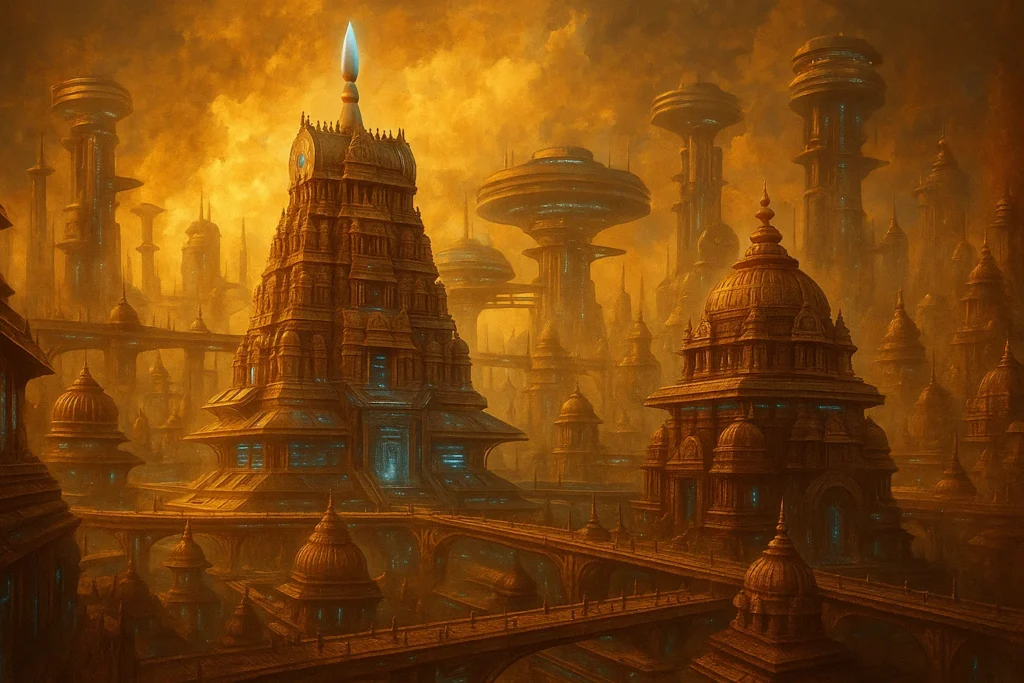
VI. Joining a Sampradaya
Once you have severed, you will find solace in many communities of our culture.
Hinduism is based on the concept of many sampradayas or sects that you can join to feel as part of a tribe, which is part of our bigger overall family. This sampradaya will become your emotional and social support system, helping you stay on your path.
Note that a sampradaya is different from a Vedic school of thought (which is a philosophy that a sect might be following) – and there are many of those, such as Advaita, Dvaita, Vishitadvaita, Achintya Bheda Bheda, Tantra, etc. If you’re new to these terms, this video does a great job of introducing them in an engaging manner.
We have four major sampradayas originating from India.
- Vaishnav – worshipping Vishnu & his forms
- Shaiva – worshipping Shiva & his forms
- Shakta – worshipping Devi/Shakti & her forms
- Smarta – worshipping a group of Gods together
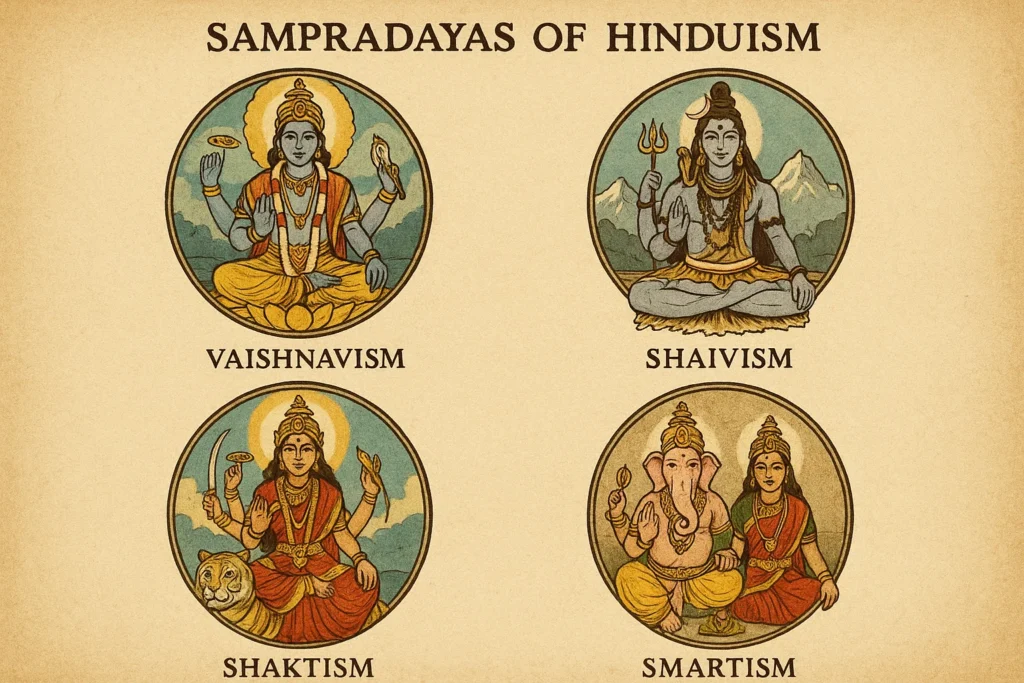
Each of these great movements or families has their sub-sects, off-shoots as well as regional variations, shaped by the local lore & traditions of each part of our country.
There are some independent & new ones, too, which we will shortly cover.
Below, you’ll find a list of all such groups, and if any of them trigger your curiosity, you can Google and look into them to find the temples or community centers in your neighborhood where their members gather.
Feel free to explore as many sampradayas as you want before you settle on one, but also keep in mind that most Hindus do actually participate in more than one sampradaya at the same time, which is fine.
Each sampradaya will have its own conversion or initiation ceremony, in which you will be called to offer certain offerings to the holy fire (Agni), be asked to recite certain mantras or pledges, and adorn a thread (janeu) if male, or a tilak and any other symbols to mark your entry in our faith.
Just consult the priest or elder/senior of your sampradaya for further guidance on this, and be sure to offer them a generous dakshina (donation) for their kind service.
You can officially mark the occasion by printing & filling out this free Hindu Conversion Certificate Template Document, which has space to mark your own name and date. You may share a copy of this certificate online & on social media if you like to declare your new identity, or just keep it framed/laminated in your own house for your personal satisfaction.
Once you’re in a sampradaya, your Hindu life may begin – it has two major practices, one that is bigger than you, and one that is all about you. So let’s explore those!
1) Vaishnavism
The Vaishnavs are devoted to Lord Vishnu and his Avatars like Sri Rama & Krishna, considering him or them to be the Supreme Brahman, the ultimate Truth.
In this fold, you have many sects, each founded by a distinguished saint-philosopher.
1.A) Advaitins
- Believe in Advaita Vedanta, popularized by Sri Adi Shankaracharya, the great reviver of Sanatan Dharma
- Believe in non-duality, the idea that we & the universe are one & the same
- Do worship God but believe in His ultimate nirguna form (without qualities, taking on qualities as per the worshippers’ wish to help them understand better)
- Operate in various mathas or schools throughout India
1.B) Sri Vaishnavism
- Founded by Ramanuja (with prior lineage in Yamunacharya & Nathamuni)
- Believe in Vishithadvaita (qualified non-dualism)
- Called Sri Vaishnavs
- Devoted to Vishnu-Lakshmi (Lakshmi is his consort)
- Honour the 12 Alvars, mystic poet-saints from Tamil Nadu
- They have various mathas or ashrams
- Concentrated in the South
1.C) Brahma
- Founded by Madhavacharya of Karnataka
- Believe in Dvaita Vedanta (dualism)
- Worship Vishnu & Krishna
- Called Madhvas or Tattvavadins
- Concentrated in the South
1.D) Kumara
- Founded by Nimbarka, who revered the 4 Kumaras as the original teachers
- Believe in dvaitadvaita (dualistic-nondualism), also called Bhedabheda (difference & non-difference)
- Worship Radha-Krishna as their main deities
- Called Nimbarkis or Sanakadis
- Located in Rajasthan, Vrindavan region & pockets of Andhra
1.E) Rudra
- Famously propogated by Vallabhacharya
- Believe in Shuddhadvaita, pure non-dualism
- Believe that Krishna is the only relaity and this world is real
- A division of this is also called Pushtimarg, the Path of Grace
- Followers are called Pushti Margis of Vallabhites
- Concentrated in Gujarat & Rajsthan, worshipping forms of Krishna like Srinathji or Thakur
1.F) Gaudiyas
- Founded by Sri Chaitanya Mahaprabhu of Bengal
- Believe in Achintya Bhedabheda – the inconceivable oneness & difference between us + God
- Worship Radha-Krishna as their supreme reality
- Believe in bhakti, sharanagati (surrender) & naam sankirtana (chanting the God’s holy names often in groups)
- Known as Gaudiya Vaishnavs (owing to their origins in the Gaud region)
- Concentrated in Bengal & Odisha
1.G) ISKCON
- Is a modern offshoot of the Gaudiya bhakti movement
- Stands for The International Society for Krishna Conciousness
- Is one of the largest infrastructures of Hindu faith at the global scale
- Founded by A.C. Bhaktivedanta Swami Prabhupada in New York (a unique aspect, since it has non-Indian origins)
- Popularized the Hare Krishna mantra chanting movement
1.H) Ramananda
- Founded by Swami Ramananda in 14th century
- He was a disciple from the Ramanuja Sri Vaishnava lineage
- Believe in Lord rAM AS THE PRIMARY DEITY
- Followers are called Ramanandis or Bairagis
- Revere texts like Valmiki’s Ramayana & Tulsidas’ Ramacharitamanas
- Concentrated heavily in North India
1.I) Swaminarayan
- Founded by Bhagwan Swaminarayan in Gujarat in 1781-1830
- He was a great social reformers & built many temples across Gujarat & North India
- Now split into many sub-sects & distinct branches or organizations, the largestof which is BAPS (Bochasanwasi Shri Akshar Purushottam Swaminarayan Sanstha) with millions of followers worldwide
- Ephasies on strict ethical codes
- This community is highly organized like a corporate entity & has a deep emphasis on community service
1.J) Warkari/Varkari
- Worship the local regional form of Krishna, Vithoba or Vitthal, a clad-black deity standing on a brick, a saviour of the poor or common man
- Has millions of followers in Maharashtra, with many coming from lower or middle-class families, heavily concentrated in the agrarian community
- This sect organizes the most beautiful & largest pilgrimage tour in the world during the Ashadi Ekadashi festival
- Their center of worship is the town of Pandharpur
- Driven bysaints like Jnyaneshwar, Namdev, Tukaram & Chokhamela, who all emphasised equality, compassion & social inclusion
1.K) Jagannathis
- Refers to followers of Lord Jagannath, a deity primarily worshipped in the eastern state of Odisha
- Temple in Puri, Odisha, is a major pilgrimage site & also home to the famous Jagannath Yatra procession
- The word itself translates to “Lord of the Universe”
- The British saw this magnificient celebration, coining the word “juggernaut”, which means huge & indesctructable
1.K) Other sects
- Ekasarana Dharma (Assamese Vaishnavism) of Srimant Sankaradeva in Assam
- Pranami by Devachandra
- Radha Vallabha by Hit Harivams
- Baula & Sahijya samaj, mixing tantric practices
- Therapanthi from Rajasthan
- Mahanam in Bengal
- Manavala Mamuni in Tamil Nadu
2) Shaivism
Shaivas worship Lord Shivas the Supreme Reality – he thus carries the epithets Mahadeva & Maheshwara. Shiva takes on many forms, from the dancing Nataraja to the fierce howling Rudra, to the abstract phallic Linga to the deadly Bhairava, to the blue-throated Neelkantha, to the animal lover Pashupati.
All forms are regarded as the manifesations of the Paramshiva, the Highest God.
Shaiva sects emphasize yoga, renunciation & self-purification.
2.A) Shaiva Siddhanta
- Orthodox Shaiva school concentrated in South India & Kashmir to some extent
- Recognises three main principles – Pati (Shiva), Pashu (the individual soul) & Pasha (the bonds of matter/karma that bind the soul)
- Usually refers to the Tamil Shaivites who follow Agamic scriptures – 28 main Shaiva Agamas
2.B) Pashupata Shaivism
- Earliest known Shaiva sect, founded likely by Lakulisa
- Pashupati is the Lord of cattle, animals & souls
- Emphasis on vows, meditation & mantra
- Has presence in Gujarat, Rajasthan, Himalayan regions, believed to have also spread to Cambodia & Java
2.C) Trika (Kashmiri Shaivism)
- Refers to Shiva as the one reality & the entire world as His real manifestation – every soul must recognize its own identity as Shiva (prayabhijna), hence different from Shaiva Siddhanta which believes Shiva & the soul are different
- The entire universe is a spanda or spontenous expression of Shiva’s creative energy, called Shakti
- The sadhanas (spiritual practices) are designed to create self-awareness of this through meditation, rituals & yogic disciples
- Initiation by a competant guru is extremely required
- It originated in Kashmir, almost vanished because of Islamic invasions in that region, but is now making a comeback
2.D) Virashaivism (Lingayatism)
- Started in & around Karnataka by Basava & others
- Worship the heoric form of Shiva (hence Vira)
- Followers wear the linga, the infinite pillar of fire and/or the phallic form of Shiva
- The linga also refers to the male energy/part required for procreation i.e. in one way, the penis – this is not laughed upon or considered dirty in our culture, its just how nature works – when combined with the yoni (female womb or uterus) it becomes the complete Shiva Linga structure you’ve seen in movies or temples
2.E) Nath Yogis
- A yogic order tracing origins to Matsyendra Nath & Gorakhnath, renowed for developing Hatha Yoga (blending physical exercises with spiritual yoga)
- They rever Shiva as the Adi Nath (the first guru & teacher)
- Some sects also believe in Dattatreya or Dattaguru, the combined avatar of Shiva, Vishnu & Brahma
- They are less about mass following & more of a network of ashrams (maths) where the yogis reside
2.F) Kapalikas & Kalamukhas
- Extreme, esoteric sects (esoteric means secretive groups with practices that are usually considered abnormal)
- Bear human skulls & wear black masks on their head, also participating in blood offerings, meat & liquor consumption, sexual rites & dancing on crematorium grounds
- These tantrik practices are heavily misunderstood – they are meant to purify & break the bondages of material comfort, so they must be seen with respect & not disgust
2.G) Dashamni Sannyasins
- A monastic (i.e. monks & aesetics who have renounced normal material life) Shiva-leaning order reorganized by Adi Shankaracharya
- They believe in the 10 appellations i.e. titles or names given to people entering the sect – Giri, Puri, Bharati, Vana, Sagara, Sarasvati, Tirtha & Parvata
- These titles are associated with one of the four major mathas or spiritual centres that Shankara founded at Sringeri, Dwarka, Puri & Joshimath
2.H) Ganpatyas
- Worship Ganesha as the Supreme
- Wear red circular tilaks on the forehead
- Practice Ganesha worship & revere texts like Ganesha Purana
- Heavily concentrated in Maharashtra & Western India
2.I) Karttikeya/Skanda (Kaumara)
- Devotees worship Lord Kartikeya (Murugan), the son of Shiva, as the Supreme God
- Sect is particularly vibrant in Tamil Nadu, where Murugan is beloved as the “Tamizh Kadavul” – Tamil’s own God
- Worship of Skandra is done in 6 famous temples, often placed on hills as Murugan is seen as a deity of hills
3) Shaktas/Tantra
The Shaktas believe the Divine Feminine (Shakti or Devi) to be the highest reality. So the Devi takes the front seat, becoming the source of even the pure cosmic conciousness (Shiva), along with all of material reality, including Brahma & Vishnu.
Devotees of the Goddess & her many forms are found throughout India, but mainly concentrated in West Bengal, Assam, Odisha, Himachal, Kerala & Tamil Nadu.
Major forms of Goddesses are Durga, Saraswati, Lakshmi, Kali, Parvati, Sarasvati, Tripura Sundari, Chandi, Kamakhya, Mariyamman, etc.
The Shaktas do not have clear-cut sects but they are largely classified into two streams depending on their style of worship – the Srikula, family of Sri & the Kaikula, family of Kali.
The Srikulas have more publicly palatable ways of worship, focusing on the beautiful, auspicious divine forms of Sri, like Lakshmi & Lalita.
The Kalikula have more esoteric (secretic) & unorthodox forms of worship, focusing on fierce forms of the Devi, involving many tantric practices that are misunderstood but carry deep meaning & logic to their process.
More specifically, followers worship the Dashamahavidyas, the 10 fierce forms of the Goddess who can accelerate the karmic process & bring you spiritual progress fast, often at the cost of temporary tests & pain/suffering/loss.
A formal initiation into their sadhanas is a critical part of the process, as doing random Mahavidya worship without a guru’s guidance might not only not give you the results you’re looking for, but also cause you problems since their energies are very potent.
Most of the times, Devi worship is used interchangeable with the term “Tantra”, which refers to the union/tying of oneself to the spiritual realm. This is done using tools like mantras (audio or sonic energies), yantras (their physical waveforms), and homely/everyday materials.
Some scholars argue that Tantra likely emerged as a parallel or alternative form/style of worship in response to the rise of orthodox Brahmanical traditions (Brahmanas = initiate preservers of Vedic knowledge), which may have, at times, excluded women or normal/common people from performing some kinds of Vedic rituals.
3.1) Sri Vidya (Tripurasundari)
- Focus on Sri Lalita Tripurasundari (the Beautiful Goddess of the Three Worlds i.e. heaven, earth & hell)
- They believe that the entire universe is an emanation of the Mother’s bliss, realization of identity with her (Shiva-Shakti) union is our goal
- They worship the Sri Yantra/Chakra, a mystical geometric diagram, along with the 15-syllable mantra
- This form of worship is strong in Tamil Nadu, North East, Andhra, Kerala & some other regions
3.2) Kali Kula (Kaula)
- Focus on clad-black, fierce Kali Ma & her allied fierce forms
- Also called left-hand Devi worship or Vamacharya (left hand because its less common, as opposed to right hand i.e. Dakshinacharya form of worship)
- Some Kaula sects embrace the Panchamakara – Madya (wine), Mamsa (meat), Matsya (fish), Mudra (parched grain or gesture), Maithuna (ritual sex or intercourse) – these are not dirty, they’re meant to remove the disgust of the human mind (also seen as an attachment) & transcend the practicing seeker beyond the material realm
3.3) Shakti Peetha Temple Sects
There are up to 51 classical Shakti Peethas or sacred seats of the Goddess, where it is believed that the parts of Goddess Sati’s body fell after she burned/immolated herself in protest of her father Daksha’s disrespect towards Shiva, as per one story in Shiva-based texts.
Many of these Shakti Peethas have their own local devotees, traditions & hereditary priests (passed on from generation to generation).
This includes:
- Kamakhya Devi (famous for a “bleeding” Goddess)
- Kanci Kamakshi
- Vaishno Devi (J&K)
- Jwalamukhi & Naina Devi (Himachal)
- Kalighat & Dakshineshwar (Kolkata)
- Vidhyachal (UP)
They are major pilgrimage centres that draw followers during annual festivals like NAVRATRI, where nine forms of the Goddess are worshipped.
3.4) Other Forms of Devi Worship
Many people temporarily become Shaktas during the Navratra (Durga Puja) period, reciting the Devi Mahatmya from the Markandeya Purana to invoke the Goddess who slew the demons Mahishasura & Shumbha-Nishumbha.
There is a huge Durgo Pujo festival in Bengal, the biggest festival there with its own pandals & celebrations that last 5 days. The rest of the country celebrates Dussehra, combining the victory of Lord Ram over the evil Ravan.
Local forms of Devi worship include Tulja Bhavani Aai (in Maharashtra), Ambaji (in Gujarat), Hadimba (in Himachal), and Chamundeshwari (in Karnataka).
3.5) Modern Forms/Neo-Shakta
We’ve also had new generations of Shakta worshippers who have each started their own sects of Devi worship.
For example, we have the lineage & tribe of Ramakrishna Paramahansa, a renowed guru who was a Kali Ma Bhakta, famous for his intense Sadhanas. He also had his wife, Sri Sarada Devi, who is revered as the Holy Mother, a reincarnation of the Devi in human form.
Swami Vivekananda was one of Ramakrishna’s most famous disciples & successors, responsible for spreading the message of our Dharma in the West.
Then lastly, we have Brahma Kumaris, a new religious movement from North India (started in modern-day Pakistan in the 1930s), led by women leader chiefs who give importance to Jagadamba (the World mother).
The Brahma Kumaris practice Raja Yoga – meditation is a central practice, aiming to connect individuals with their inner selves and the divine.
They are now an international organization with inter-connected centres, chielfy women-centric, doing good work as an international NGO, engaging in various social initiatives.
4) Smarta
Smartism is not a sect per se with one founder, but a collection of Hindu practices that revere multiple Gods.
It was crystalized by the Advaita guru Adi Shankaracharya, who believed the Brahman is Nirguna (originally without qualities) but takes many forms for devotees as guiding points to realise their Oneness with that Brahman.
And all of these forms are valid & can be worshipped, not as the Ultimate Truth but as pathways towards it.
The major deities include in his proposed Panchayatana Puja, as the name suggests, are five in number – Shiva, Vishnu, Surya, Devi & Ganesha, with Karttikeya added as the sixth one sometimes.
Almost all Smartas are by default Advaitins because they believe that the actual real Brahman is One, without a second, and the individual soul is actually identical to the Brahman (not different, hence is named “advaita” – not two).
Smartas undergo upanayana (sacred thread ceremony) & learn to recite the Gayatri Mnatra as Vedic initiation. They are known for their tolerance of all forms of worship & deities, being dubbed the “universalist” sect which was key in holding different Hindu faiths together with one thread, thanks to Shankara’s uniting influence.
Smartism can be thought of as “Hinduism as a whole” – it honors all major deities, follows the smriti (law books and Puranic traditions) & sruti (Vedas), and upholds Jnyana (knowledge), Vedic yajnya along with bhakti.
As a Smarta ideal says: “Ekam sadviprā bahudha vadanti” – “Truth is One, the wise call it by many names.”
This encapsulates the Smarta philosophy of one God manifesting as Vishnu, Shiva, Devi, etc.
5) Other sects
That’s not all – we have many more sects to cover!
- Saurya (Sauram) – Worship the Sun God as the supreme, with deep roots in Vedas that have several hymns dedicated to praising Surya Dev
- Brahmo Samaj – Started by Raja Ram Mohan Roy in 1828 in Kolkata, rejecting murti-puja (idol worship), caste restrictions, etc. instead owrshipping the formless Brahman through simple prayer & Upanishad readings
- Arja Samaj – Founded by Swami Dayanand Saraswati in 1875 to revive Vedic learning, opposing idol worship or rituals but also systemizing the Shuddhikaran ceremony as a tool to bring back converted Hindus back into our fold; they also are seen as fierce social reformers, opposing social evils like castesim, child marriage & sati practice
- Ramakrishna Mission – Started by Swami Vivekananda in 1897, espousing Vedanta (Vedic knowledge, especially its Advaita interpretation & POV), aiming to create harmony of all world religions; worshipping Ramakrishna as an avatar & Sarada Devi as the Holy Mother
- Theosophical Society – Not a Hindu sect but embraces Hinduism with other religions, aiming to create global religious harmony, with famous members like Annie Besant & Sri Aurobindo influencing the movement & also playing a huge role in our struggle for Independence
- Self-Realizaiton Fellowship (Yogoda Satsanga) – Founded by Paramahansa Yogananda in 1920, who wrote the world-famous bestseller “Autobiography of a Yogi” – it teaches a meditation technique called “Kriya Yoga” that rapidly advances spiritual growth
- Chinmaya Mission – Founded by Swami Chinmayananda in 1953, focuses on Advaita Vedanta through lectures called jnyana-yagnas (literally sacrifices of knowledge) – it is quite famous amongst kids & parents alike because they set up many schools & institutions for social welfares, with camps & workshops for kids, teaching the new generations our culture & ancient wisdom
- Divine Life Society (Sivananda) – Founded by Swami Shivananda of Riskhikesh, who trained thousands of yoga teachers/monks to spread yoga around the world – propogating the motto “Be Good, Do Good”
- Art of Living (AOL) – Founded by Sri Sri Ravi Shankar in 1981, it is one of the greatest organizations teaching breath-based Sudarshan Kriya & other forms of meditations like Sahaj Samadhi to beginners around the world. By combining Ayurveda-based living, chants & social service, it is one of the most inclusive spiritual movements in the modern era
- Isha Foundation – Founded by Sadhguru Jaggi Vasudev in Tamil Nadu in 1992, it teaches inner engineering (a blend of yoga, meditation & social/community service). It is famous for building the huge 112 ft. Adiyogi Shiva statue in Coimbatore, Tamil Nadu; Sadhguru combines Shaiva Tantra with modern living, combining the wisdom from Upanishads with grassroots activism to save our rivers like Cauvery & rebuild natural beauty
VII. Doing Seva (Community Service)
Now that you’ve integrated yourself into a community, its time to serve it. Hinduism is all about connecting a larger whole that’s bigger than yourself.
So social service is at the heart of our Dharma.
One way to mark this occassion of becoming a Hindu is to feed poor kids or rescued animals at shelters, volunteering your own time and effort. You may also donate to a charity and sponsor the food donation but you being there on the spot is highly recommended.
Its wise to automate a monthly online donation streak to your chosen charity or NGO near you – the goal is to make someone’s life better by donating water, food, clothes, shelter, time, money, and/or even knowledge i.e. education.
If it can’t be automated, you can set a reminder & make it a ritual – trust me, giving (daan) feels really good & more importantly, it purifies you.
In one way, helping mankind & uplifting someone poor or needy is a far better, higher, more beneficial & purer form of worship than simply showing flowers & foods to idols in temple – of course, that has its own distinct purpose but it doesn’t come close to daridra narayana seva – the service of God sitting inside the poor, voiceless & helpelss.
Every Saturday, for example, (as its the day of Lord Shani, the deity associated with Karma), I donate a small amount taken out of my salary to PAL (Pet Owners & Animal Lovers), my chosen NGO – they are doing wonderful work rescuing stray dogs, cats & also farm animals, nursing them back to health & putting them up for adoption in forever loving homes.
If animal welfare & rescue is a cause you personally care about too, then you can use this database to locate the registered NGO/shelter near you & support their efforts in any way you can.
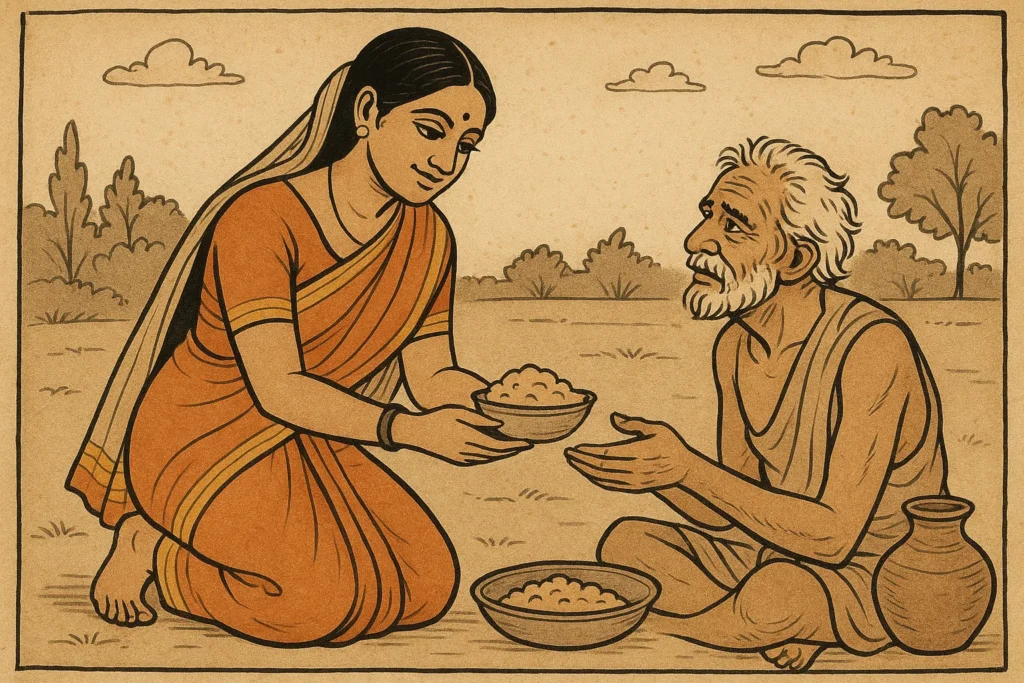
Beyond seva/service, a Hindu way of life has many more practices, which are outlined as diary entries below.
Note that this list includes pointers of “ideal” practices and beliefs – they’re not meant to romanticise or even generalise the complex Hindu life – this is just a simple attempt at fictionally depicting how Hindus usually think and behave, serving as a starting point for you to mould your life accordingly.
WAKING UP EARLY – I wake up at 4.30 – 5 AM (or as early as possible) as this is a Brahma Murtha (an auspicious time to begin our day, also validated by many great successful thinkers)
KEEPING BODY HEALTHY – After freshening up and brushing my teeth, I join my yoga class – this is not to learn mere posture and breathing techniques, the asanas make my body flexible and healthier (especially with complete body exercises like the Surya Namaskara), which leads to my body being sound, which eventually affects my mental state, making me energised yet also calmer for the rest of my day
KEEPING SURROUNDINGS CLEAN – I take bath, keep myself well-groomed, and also clean up my bed along with tidying my entire room, because if my body and environment is clean, my mind will be, too.
DOING SADHANA – For 15 minutes, I sit down to do my sadhana meditation on my Ishtadev, i.e. my chosen deity and personal coach (you’ll learn how to choose your Ishtadev soon). chanting the mantra a priest from the local mandir has “initiated” me into (authorised me to use daily). I pray in gratefulness, not asking for anything in return or wishing for anything – because prayer should not be a transaction with God; it should always be done as an exercise of humility and thankfulness for whatever we are going through in life.
WEARING A JANEU – I chant the Gayatri Mantra 10 times, thanking Surya Deva for giving me warmth and energy, energising the sacred thread (janeu) given to me in my upanayana or yagnopavit ceremony (usually men wear it but women are also allowed) – like a machine needs daily maintenance, chanting the Gayatri Mantra keeps the thread “activated.” This thread acts as a reminder for myself that I am walking the path of Dharma – whenever I feel the urge to indulge in any pleasure to the senses (e.g. sex, excess food, drinks, drugs, anger, hurtful conduct), this thread literally pulls me back so I respect it.
SHOWING BHAKTI i.e. UNCONDITIONAL LOVE – I offer a couple of flowers to the Ganesha idol on my study table and light an incense stick – although God has no form, I worship him as this idol merely as a point of focus – I do not believe he actually “lives” in idols or images – but this idol serves a focus point for me to understand, experience and love him as a friend, my personal God, the Bhagavan. I treat him as my forever buddy and love him like one, without selfishness, desires or expectations.
FOLLOWING SVADHARMA – I head off to work because it is my karmabhumi – I cannot abandon my work, my career, my duty, to pursue spirituality. Inaction is not the way. I must work hard with sincerity without any personal expectations or desires, so I can generate “artha” (wealth/money generated for the purpose of redistributing it to the society). Basically, I strive to be successful or do business not because I want to personally benefit, but so that I can be in a position to give back and help others freely.
DOING BHUTASEVA – On my way, I feed the stray dogs in my neighbourhood – I show them love and give them pats. I feed the cow and give hot breakfast to her caretaker aunty. All creatures (bhutas) are holy in my Dharma, no animal is dirty or inferior or bad. I also buy a snack for the poor kid who lives down the street, and offer it to them as I wait for the bus. Daan i.e. donation, charity, and social welfare is the highest duty – it is all-cleansing for the soul. It keeps us humble and kind.
BEING RESPECTFUL and CALM AT WORK – At work, I encourage healthy competition but ultimately see everyone as the same team, and try to work peacefully together with all kinds of people, always keeping my anger in check even if anyone provokes me because I know that it is one of the six big evils – krodha (anger), madha (pride), lobha (greed), kama (lust), moha (delusion or attachment), and matsarya (jealousy).
BEING ETHICAL IN BUSINESS – Whether I’m doing my own business or employed, I put ethics first firmly and do not give in to the temptation of taking decisions that would knowingly hurt someone or cause them loss. I try to keep up the attitude of “We all profit, we all win.”
FOLLOWING A SATTVIC DIET – At lunch and all my other meals, I try my best to have “sattvik” food as much as possible – this is fresh, natural, light, non-spicy food that creates “sattva” i.e. the quality of inner peace and goodness in my mind, unlike tamasic or rajasic food that’s manufactured, very spicy, very pungent, or frozen – which creates lethargy and/or anger and desire.
AVOIDING ANIMAL PRODUCTS IN DIET – I do indulge in new cuisines or junk food I like sometimes (it’s alright) but always, in all circumstances, follow a cruelty-free, sattvic diet – by cruelty-free, I mean to be plant-based or vegan as I avoid animal ingredients like meat, eggs, honey, fish and dairy – cruelty to animals, through diet, too, is forbidden in my culture.
SUPPORTING LOCAL TEMPLES – On my way back home, I pay a trip to my local temple, supporting it by giving a small donation and thanking the priest Guruji for their service. I usually avoid big public crowded temples and instead try to do my bit in saving the little local ones. One may not believe in idol worships but they should still support temples because they are the pillars of our culture, they are essential in keeping our culture alive, just as a hospital is essential in keeping the people in a community alive. Temples are our heart and soul.
SERVING ONE’S FAMILY UNCONDITIONALLY – I come home and take happiness in spending time with my family and serving my parents in whatever way I can – not as an attachment (because even calling them “yours” is a form of bondage) – but as a gesture of thanks, also because it is one of the five debts I must pay in this life – debt to ancestors and parents (by remembering and donating food in their name), debt to the elements (by thanking them), debt to the society (by doing service and uplifting the needy), debt to animals and creatures (by feeding and sponsoring care for animals, and by adopting a cruelty-free, plant-based diet), and debt to gurus/rishis (by thanking our teachers, mentors and those who give us knowledge).
CELEBRATING FESTIVALS – I go down to celebrate the festival that’s going on right now (e.g. Diwali, Holi, Ganesh Chaturthi), thinking of it as an opportunity to connect with the community and build strong social ties so we can help each other out
GOING FOR SPIRITUAL PILGRIMAGES – Before sleeping, I browse the internet to plan my trip to the holy place of Rishikesh. I make it a point to go to holy spots every six months, not to gain anything but to meet other spiritual seekers there and just bathe in the good vibes of those places.
BEING GRATEFUL – I say a short prayer and meditate for 5-10 minutes before sleeping, thanking the Creator for everything, even my miseries, sadness, pain and losses because even they are lessons and gifts, no matter how inconceivable it may be for us. I always keep Them at the center of my mind, and go to sleep, embracing this life fully, knowing I am pure, I am eternal, I am infinite.
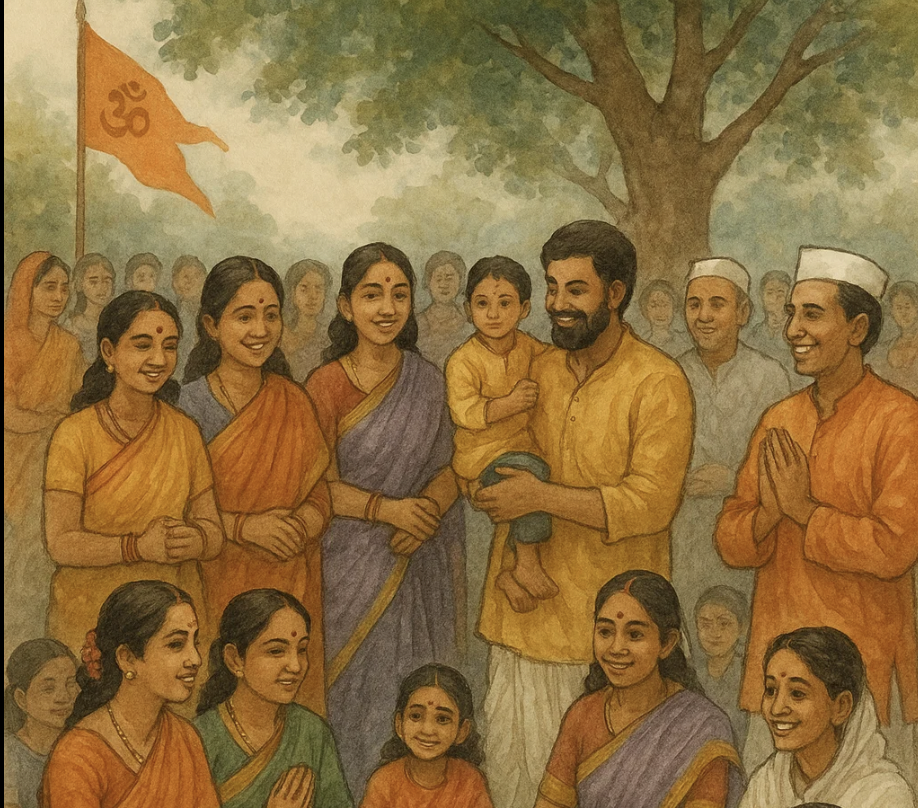
VIII. Starting your Sadhana (Meditation)
Besides social service, the second out of the two complimentary goals of the Hindu life is to help you realise your own true nature through sadhana (daily ritual meditation) & tapasya (austerity or strict disciplined living).
Your chosen guru (who you must seek yourself by embarking on pilgrimages or tours, as true gurus will never come to you or try to market themselves) will give you mantras, daily chanting codes that unlock your spiritual growths.
While some mantras do not need initiation (like Hare Krishna), most need it because mantras are raw energy – chant them by yourself and you risk unlocking energies that you may not be able to handle, causing heavy karmic effects that hurt or damage you.
So always seek out a formal mantra-deeksha (diksha).
But which deity/God’s mantra should you chant? Usually, you will have already found that answer if you’ve chosen a sampradaya.
But if not, you may be seeking a primary deity to worship & focus your energy on, although I’ve already clarified that many Hindus do worship different Gods simultaneously, which is NOT prohibited by our scriptures.
Your spiritual growth requires a coach. And that’s where your Ishtadev comes in – your personal chosen form of God (Bhagavan) who will take you ahead on this journey.
Read this quick blog to understand how you can find your Ishtadev as per your kula (lineage) or birth chart (kundali). The sampradaya you’ve joined will have its main deity anyway so that can be your Ishta by default … or you can first lock your Ishta then find the connected sampradaya.
Or better yet, use my Ishtadev GPT, a custom AI bot designed to prescribe an Ishta as per your natural inclinations & needs.
It is recommended to stick to your chosen Ishta otherwise you lose focus & end up achieving nothing.
At the beginning, you may not connect with the power, but keep faith & keep enduring – in a year or two or three, you will slowly start sensing the deity’s energy all around you.
They will become your mentor & tell you what to do.
Sometimes, a deity themselves may call out to you.
Do not panic, do not fear the deities who are doing their jobs. Just consult the priest to understand how their sadhana is done.
Sometimes, in certain Sadhanas, especially Tantric ones, your life might be thrown into chaos as a test, with family or friends abandoning you, or the loss of all your wealth.
This is a test, it is a breakdown of your ego & everything that has been holding you back. It is a watershed moment of cleansing your past karmas so please do not abandon your faith.
In Hinduism, we say that you cannot choose your path, the path chooses you.
And if you’ve read this far, it already has.
Stay strong. Stay curious. And continue this journey with utmost faith – that is the most important ingredient of all.
I leave you here, and wish you all the best. Reach out on Insta @manikthinks to share your experience!
